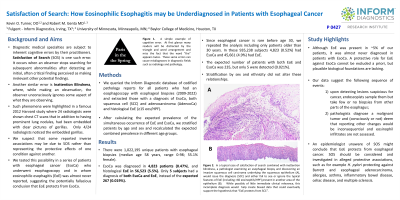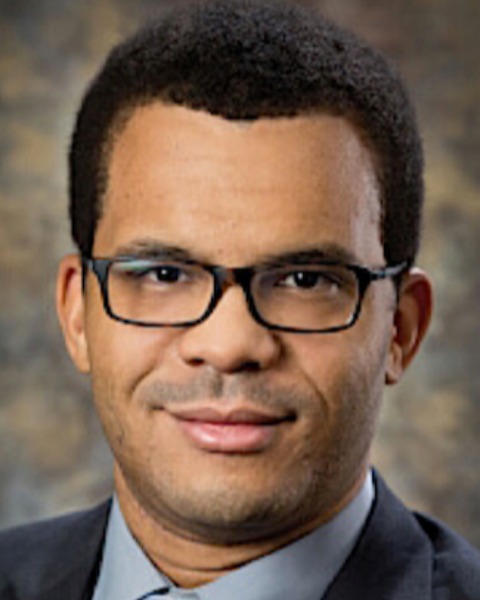Sunday Poster Session
Category: Esophagus
P0427 - Satisfaction of Search: How Eosinophilic Esophagitis May Be Underdiagnosed in Patients with Esophageal Cancer
Sunday, October 22, 2023
3:30 PM - 7:00 PM PT
Location: Exhibit Hall

Has Audio

Kevin Turner, DO
University of Minnesota
Minneapolis, Minnesota
Presenting Author(s)
Kevin Turner, DO1, Robert M. Genta, MD2
1University of Minnesota, Minneapolis, MN; 2Baylor College of Medicine, Irving, TX
Introduction: Satisfaction of search (SOS), an error known to afflict diagnostic radiology but likely to affect other medical specialties, occurs when observers stop searching for other abnormalities after detecting an initial, often critical lesion that would make other potential findings clinically irrelevant. Some reported inverse associations may be due to SOS rather than to mutually protective effects of two conditions. We tested this possibility in a series of patients in whom EoE was rarely diagnosed when esophageal cancer (EsoCa) was present, suggesting the potentially fallacious conclusion that EoE protects from EsoCa.
Methods: We queried the Inform Diagnostic database of codified pathology reports for all patients who had esophagoscopy with esophageal biopsies (2009-2022) and extracted those with a diagnosis of EsoCa (squamous cell and adenocarcinoma) and EoE (≥15 eos/HPF). After calculating the expected prevalence of the simultaneous occurrence of EoE and EsoCa, we stratified patients by age and sex and recalculated the expected combined prevalence in different age groups.
Results: Of 1,022,195 unique patients with esophageal biopsies (age 58 years, range 0-98; 55.1% female) 4,823 (0.47%) had EsoCa and 56,523 (5.5%) had EoE. Only 5 subjects had both EsoCa and EoE, instead of the expected 267 (.019%). Since esophageal cancer is rare before age 30, we repeated the analysis including only patients >30-year-old. In these 935,238 subjects 4,823 (0.52%) had EsoCa and 45,661 (4.9%) had EoE; the expected number with both EoE and EsoCa was 235, but only 5 were detected (0.021%). Stratification by sex and ethnicity did not alter these relationships.
Discussion: EoE, present in ~5% of our patients, was hardly diagnosed in those with EsoCa. A protective role for EoE against EsoCa cannot be excluded a priori, but plausible biological foundations are lacking. Our data suggest the following sequence of events:1) upon detecting lesions suspicious for cancer, endoscopists sample them, but take few or no biopsies from other parts of the esophagus; 2) pathologists diagnose a malignant tumor and (consciously or not) deem that reporting other changes would be inconsequential, and eosinophil infiltrates are not assessed. An epidemiologist unaware of SOS might conclude that EoE protects from esophageal cancer. SOS should be considered and investigated in alleged protective associations, such as H. pylori protecting from Barrett and esophageal adenocarcinoma, asthma, IBD, celiac disease, and multiple sclerosis.
Disclosures:
Kevin Turner, DO1, Robert M. Genta, MD2. P0427 - Satisfaction of Search: How Eosinophilic Esophagitis May Be Underdiagnosed in Patients with Esophageal Cancer, ACG 2023 Annual Scientific Meeting Abstracts. Vancouver, BC, Canada: American College of Gastroenterology.
1University of Minnesota, Minneapolis, MN; 2Baylor College of Medicine, Irving, TX
Introduction: Satisfaction of search (SOS), an error known to afflict diagnostic radiology but likely to affect other medical specialties, occurs when observers stop searching for other abnormalities after detecting an initial, often critical lesion that would make other potential findings clinically irrelevant. Some reported inverse associations may be due to SOS rather than to mutually protective effects of two conditions. We tested this possibility in a series of patients in whom EoE was rarely diagnosed when esophageal cancer (EsoCa) was present, suggesting the potentially fallacious conclusion that EoE protects from EsoCa.
Methods: We queried the Inform Diagnostic database of codified pathology reports for all patients who had esophagoscopy with esophageal biopsies (2009-2022) and extracted those with a diagnosis of EsoCa (squamous cell and adenocarcinoma) and EoE (≥15 eos/HPF). After calculating the expected prevalence of the simultaneous occurrence of EoE and EsoCa, we stratified patients by age and sex and recalculated the expected combined prevalence in different age groups.
Results: Of 1,022,195 unique patients with esophageal biopsies (age 58 years, range 0-98; 55.1% female) 4,823 (0.47%) had EsoCa and 56,523 (5.5%) had EoE. Only 5 subjects had both EsoCa and EoE, instead of the expected 267 (.019%). Since esophageal cancer is rare before age 30, we repeated the analysis including only patients >30-year-old. In these 935,238 subjects 4,823 (0.52%) had EsoCa and 45,661 (4.9%) had EoE; the expected number with both EoE and EsoCa was 235, but only 5 were detected (0.021%). Stratification by sex and ethnicity did not alter these relationships.
Discussion: EoE, present in ~5% of our patients, was hardly diagnosed in those with EsoCa. A protective role for EoE against EsoCa cannot be excluded a priori, but plausible biological foundations are lacking. Our data suggest the following sequence of events:1) upon detecting lesions suspicious for cancer, endoscopists sample them, but take few or no biopsies from other parts of the esophagus; 2) pathologists diagnose a malignant tumor and (consciously or not) deem that reporting other changes would be inconsequential, and eosinophil infiltrates are not assessed. An epidemiologist unaware of SOS might conclude that EoE protects from esophageal cancer. SOS should be considered and investigated in alleged protective associations, such as H. pylori protecting from Barrett and esophageal adenocarcinoma, asthma, IBD, celiac disease, and multiple sclerosis.
Disclosures:
Kevin Turner indicated no relevant financial relationships.
Robert Genta indicated no relevant financial relationships.
Kevin Turner, DO1, Robert M. Genta, MD2. P0427 - Satisfaction of Search: How Eosinophilic Esophagitis May Be Underdiagnosed in Patients with Esophageal Cancer, ACG 2023 Annual Scientific Meeting Abstracts. Vancouver, BC, Canada: American College of Gastroenterology.
